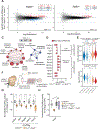A p53-dependent translational program directs tissue-selective phenotypes in a model of ribosomopathies
- PMID: 34242585
- PMCID: PMC8319123
- DOI: 10.1016/j.devcel.2021.06.013
A p53-dependent translational program directs tissue-selective phenotypes in a model of ribosomopathies
Abstract
In ribosomopathies, perturbed expression of ribosome components leads to tissue-specific phenotypes. What accounts for such tissue-selective manifestations as a result of mutations in the ribosome, a ubiquitous cellular machine, has remained a mystery. Combining mouse genetics and in vivo ribosome profiling, we observe limb-patterning phenotypes in ribosomal protein (RP) haploinsufficient embryos, and we uncover selective translational changes of transcripts that controlling limb development. Surprisingly, both loss of p53, which is activated by RP haploinsufficiency, and augmented protein synthesis rescue these phenotypes. These findings are explained by the finding that p53 functions as a master regulator of protein synthesis, at least in part, through transcriptional activation of 4E-BP1. 4E-BP1, a key translational regulator, in turn, facilitates selective changes in the translatome downstream of p53, and this thereby explains how RP haploinsufficiency may elicit specificity to gene expression. These results provide an integrative model to help understand how in vivo tissue-specific phenotypes emerge in ribosomopathies.
Keywords: 4E-BP1; limb development; nucleolar stress; p53; ribosomal protein haploinsufficiency; ribosome profiling; ribosomopathy; translational control.
Copyright © 2021 Elsevier Inc. All rights reserved.
Conflict of interest statement
Declaration of interests D.R. is a shareholder of eFFECTOR Therapeutics and a member of its scientific advisory board.
Figures







Similar articles
-
Ribosomopathies: There's strength in numbers.Science. 2017 Nov 3;358(6363):eaan2755. doi: 10.1126/science.aan2755. Science. 2017. PMID: 29097519 Review.
-
Translation defects in ribosomopathies.Curr Opin Hematol. 2022 May 1;29(3):119-125. doi: 10.1097/MOH.0000000000000705. Epub 2022 Jan 31. Curr Opin Hematol. 2022. PMID: 35102070 Review.
-
Ribosomal protein RPL11 haploinsufficiency causes anemia in mice via activation of the RP-MDM2-p53 pathway.J Biol Chem. 2023 Jan;299(1):102739. doi: 10.1016/j.jbc.2022.102739. Epub 2022 Nov 23. J Biol Chem. 2023. PMID: 36435197 Free PMC article.
-
Translational repression of Ccl5 and Cxcl10 by 4E-BP1 and 4E-BP2 restrains the ability of mouse macrophages to induce migration of activated T cells.Eur J Immunol. 2019 Aug;49(8):1200-1212. doi: 10.1002/eji.201847857. Epub 2019 May 6. Eur J Immunol. 2019. PMID: 31032899
-
Ribosomopathies: how a common root can cause a tree of pathologies.Dis Model Mech. 2015 Sep;8(9):1013-26. doi: 10.1242/dmm.020529. Dis Model Mech. 2015. PMID: 26398160 Free PMC article. Review.
Cited by
-
Metabolic rewiring during bone development underlies tRNA m7G-associated primordial dwarfism.J Clin Invest. 2024 Sep 10;134(20):e177220. doi: 10.1172/JCI177220. J Clin Invest. 2024. PMID: 39255038 Free PMC article.
-
Hepatic ribosomal protein S6 (Rps6) insufficiency results in failed bile duct development and loss of hepatocyte viability; a ribosomopathy-like phenotype that is partially p53-dependent.PLoS Genet. 2023 Jan 19;19(1):e1010595. doi: 10.1371/journal.pgen.1010595. eCollection 2023 Jan. PLoS Genet. 2023. PMID: 36656901 Free PMC article.
-
The Mettl3 epitranscriptomic writer amplifies p53 stress responses.Mol Cell. 2022 Jul 7;82(13):2370-2384.e10. doi: 10.1016/j.molcel.2022.04.010. Epub 2022 May 4. Mol Cell. 2022. PMID: 35512709 Free PMC article.
-
Look who's TORking: mTOR-mediated integration of cell status and external signals during limb development and endochondral bone growth.Front Cell Dev Biol. 2023 Apr 19;11:1153473. doi: 10.3389/fcell.2023.1153473. eCollection 2023. Front Cell Dev Biol. 2023. PMID: 37152288 Free PMC article. Review.
-
Mechanical tension-induced Dalrd3 elevation enhances osteogenic differentiation of bone suture stem cells by upregulating Id3 translation.Stem Cell Res Ther. 2025 Jun 17;16(1):309. doi: 10.1186/s13287-025-04380-9. Stem Cell Res Ther. 2025. PMID: 40528244 Free PMC article.
References
-
- Barna M, and Niswander L (2007). Visualization of cartilage formation: insight into cellular properties of skeletal progenitors and chondrodysplasia syndromes. Dev. Cell 12, 931–941. - PubMed
Publication types
MeSH terms
Substances
Grants and funding
LinkOut - more resources
Full Text Sources
Molecular Biology Databases
Research Materials
Miscellaneous

